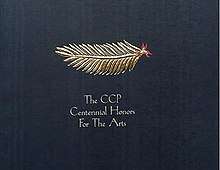Centennial Honors for the Arts
| The CCP Centennial Honors for the Arts | |
|---|---|
 | |
| Awarded for | To honor the 100 outstanding Filipinos who have contributed in building the nation through art and culture in the last 100 years |
| Country | Philippines |
| Presented by | Cultural Center of the Philippines and Philippine Centennial Commission |
| First awarded | February 2, 1999 |
The Centennial Honors for the Arts,(Gawad Sentenaryo para sa Sining) is an award given by the Cultural Center of the Philippines and the Philippine Centennial Commission to honor the outstanding Filipino who have contributed in building the nation though Arts and Culture in the last 100 years and it coincide with the 100 years of Philippine Independence. The awardees were chosen among the hundreds of nominees in different art fields like painting, sculpture, literature, theater, dance, film, architecture, and other arts. In the interest of painting a more complete picture of the development of Filipino culture, the CCP also decided to honor outstanding art patrons, cultural administrators, critics, and researchers. No distinctions were drawn between the fine arts, traditional folk art and popular art. The CCP also decided not to include the Philippine National Artists for they already received the country's highest honors for the Arts.[1]
Selection
Selection of who will be part of the accolade took a painstaking six-month process of research, study and debate for the selection committee composed of scholars, critics, curators, and artists. All 65 selection committee members were all experts in their respective fields. The initial screening came up with nearly 300 names, which were later boiled down to the final 100. This award is primarily to identify people whose contributions helped shape the nation, although they must have achieved some level of excellence in order to be as influential and trend-setting as they were.
Awarding Ceremony
The Cultural Center of the Philippines gave out the Centennial Honors for the Arts on February 2, 1999. Honorees received a gold medallion designed by Roberto Feleo in the shape of a palm leaf, which can also be seen as a comet, symbolizing their trailblazing efforts
The Roster of Honors
The complete list of awardees, in alphabetical order
|
|
